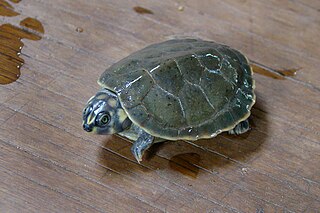
Podocnemididae is a family of pleurodire (side-necked) turtles, once widely distributed. Most of its 41 genera and 57 species are now extinct. Seven of its eight surviving species are native to South America: the genus Peltocephalus, with two species, only one of which is extant ; and the genus Podocnemis, with six living species of South American side-necked river turtles and four extinct. There is also one genus native to Madagascar: Erymnochelys, the Madagascan big-headed turtle, whose single species E. madagascariensis.

The Arrau turtle, also known as the South American river turtle, giant South American turtle, giant Amazon River turtle, Arrau sideneck turtle, Amazon River turtle or simply the Arrau, is the largest of the side-neck turtles (Pleurodira) and the largest freshwater turtle in Latin America. The species primarily feeds on plant material and typically nests in large groups on beaches. Due to hunting of adults, collecting of their eggs, pollution, habitat loss, and dams, the Arrau turtle is seriously threatened.

Podocnemis is a genus of aquatic turtles, commonly known as South American river turtles, in the family Podocnemididae. The genus consists of six extant species occurring in tropical South America. Four additional species are known only from fossils. These turtles have pig-like noses but are not closely related to the pig-nosed turtle.

The yellow-spotted Amazon river turtle, also known commonly as the yellow-headed sideneck turtle and the yellow-spotted river turtle, and locally as the taricaya, is one of the largest South American river turtles.

The Madagascan big-headed turtle is a turtle native to the waters of permanent slow moving rivers and lakes in western Madagascar. These turtles are critically endangered and have been evaluated to be the most endangered turtle in the world by a 2018 review. Due to its ancient origins and threatened status, it is ranked as #1 on the EDGE of Existence programme's list of priority reptiles.

The Big-headed Amazon River turtle, also known as the big-headed sideneck, is a species of turtle in the family Podocnemididae.

The red-headed Amazon side-necked turtle, red-headed river turtle or red-headed sideneck is a species of turtle in the family Podocnemididae. It is found in the Amazon basin in Brazil, Colombia, and Venezuela. The red-headed river turtle is considered a small turtle with a size of less than 32 cm, making it easily distinguishable from other species in the area. Identifying factors of this turtle include colors ranging from dark brown to black, barbels under the chin, and a bright red strip that goes from behind its head to the tympanum.

The Magdalena River turtle or Rio Magdalena river turtle is a species of turtle in the family Podocnemididae, which diverged from other turtles in the Cretaceous Period, 100 million years ago. It is endemic to northern Colombia, where its home range consists of the Sinú, San Jorge, Cauca, and Magdalena river basins.

The six-tubercled Amazon River turtle or six-tubercled river turtle is a species of turtle in the family Podocnemididae.
Abufari Biological Reserve is a biological reserve in the state of Amazonas, Brazil. It is mostly lowland tropical rainforest, with very diverse flora and fauna.

The savanna side-necked turtle, also commonly known as the Llanos side-necked turtle, is a species of turtle in the family Podocnemididae. The species is endemic to South America.
Chedighaii is an extinct genus of marine bothremydid side-necked turtle that inhabited eastern and south-central North America during the Campanian stage of the Late Cretaceous. It is known from two species C. hutchisoni and C. barberi. The genus name is derived from ch’ééh digháhii, the Navajo word for turtle.

Crematogaster carinata is a species of ant in the tribe Crematogastrini. It was first described by Gustav Mayr in 1862. It is native to Central and South America, where it is a common species, forming large colonies in the canopy of the forest.
Ooceraea coeca is a species of reddish-brown army ant found in Sri Lanka.
Adranes coecus is a species of ant-loving beetle in the family Staphylinidae, found in North America.
Adranes is a genus of ant-loving beetles in the family Staphylinidae. There are about six described species in Adranes.

Formica neoclara is a species of ant in the family Formicidae. It is a generalist that has been known to have mutualistic relationships with 42 different species of aphids.

Neivamyrmex swainsonii is a species of army ant in the family Formicidae.
Richard Carl "Dick" Vogt was an American herpetologist based in Brazil. He was the director of the Centro de Estudos de Quelônios da Amazônia at the National Institute of Amazonian Research (INPA).
Bairdemys is an extinct genus of side-necked turtles in the family Podocnemididae. The genus existed from the Late Oligocene to Late Miocene and its fossils have been found in South Carolina, Puerto Rico, Panama and Venezuela. The genus was described in 2002 by Gaffney & Wood and the type species is B. hartsteini.













